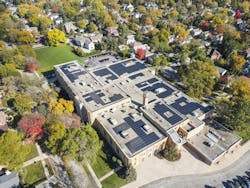NERC: Grid Strategy and modeling key to ensuring Resiliency with DER acceleration
The quickening pace of distributed energy resources added into the grid could play out in one of two ways: a resilient interconnected reward or a huge risk to reliability. Then again both results could be in play.
The North American Electric Reliability Corp., the industry-led non-profit focused on ensuring steady, safe operation of the bulk power system, has released its Distributed Energy Resource Strategy. The document is intended to identify actions needed to protect the grid as intermittent and myriad solar and energy storage resources are connected and, in some cases, replacing utility-scale generation.
Click here to read the NERC agenda on DER Strategy
Overall, it is anticipated that nearly 25 GW of distributed (rooftop and community) solar capacity will be operating in North America by the end of this year, according to NERC. Those interconnections could reach a cumulative 60 GW by 2031.
FERC Order 2222, which opens participation of aggregated DERs into wholesale energy markets, could drive those solar, microgrid and battery storage projects even higher. The potential benefits could be steeper cuts in carbon emissions from the power sector, but the risks are ratched up due to the intermittent nature of some renewables, as well as the grid infrastructure struggling to handle bi-directional flow and flucuations
NERC’s strategy on DERs in the future must include cooperation with regulators, system planners such as system operators as well as utilities and aggregators.
“NERC will continue supporting industry to enhance DER modeling capabilities and practices while working with industry experts, transmission planners, planning coordinators, distribution providers, and other relevant entities,” the strategy agenda reads.
“The primary goal is for industry to have effective DER modeling practices and planning assessments that include aggregate representations of DERs,” the NERC document continues. “It is crucial to have the aggregate DER level represented in the transmission planning base cases, and NERC is assessing the validity and accuracy impacts of DER modeling thresholds.”
Private industry companies such as AutoGrid, Stem and others are innovating with virtual power plant technologies to dispatch available capacity when the utility grid is under duress.
The Electric Reliability Council of Texas (ERCOT), which handles grid transmission for much of that state, is undertaking a pilot project to analyze the impact of DERs in the wholesale energy market.
About the Author
EnergyTech Staff
Rod Walton is senior editor for EnergyTech.com. He has spent 17 years covering the energy industry as a newspaper and trade journalist.
Walton formerly was energy writer and business editor at the Tulsa World. Later, he spent six years covering the electricity power sector for Pennwell and Clarion Events. He joined Endeavor and EnergyTech in November 2021.
He can be reached at [email protected].
EnergyTech is focused on the mission critical and large-scale energy users and their sustainability and resiliency goals. These include the commercial and industrial sectors, as well as the military, universities, data centers and microgrids.
Many large-scale energy users such as Fortune 500 companies, and mission-critical users such as military bases, universities, healthcare facilities, public safety and data centers, shifting their energy priorities to reach net-zero carbon goals within the coming decades. These include plans for renewable energy power purchase agreements, but also on-site resiliency projects such as microgrids, combined heat and power, rooftop solar, energy storage, digitalization and building efficiency upgrades.
